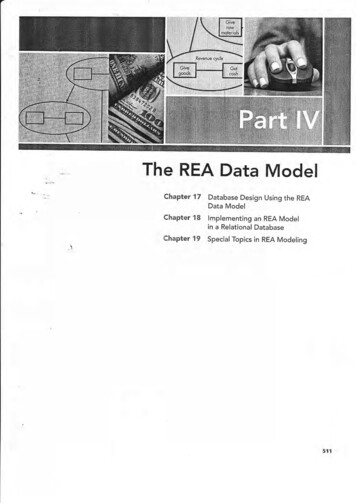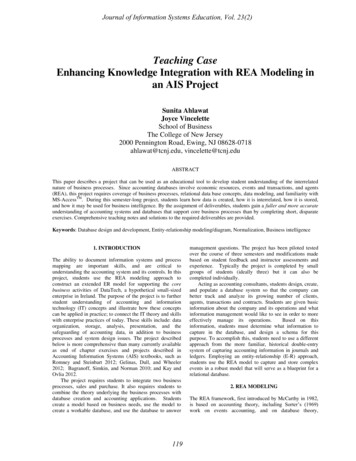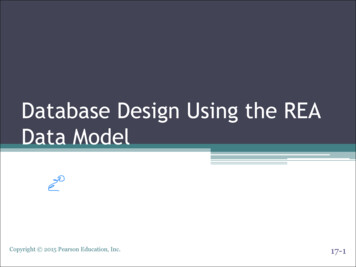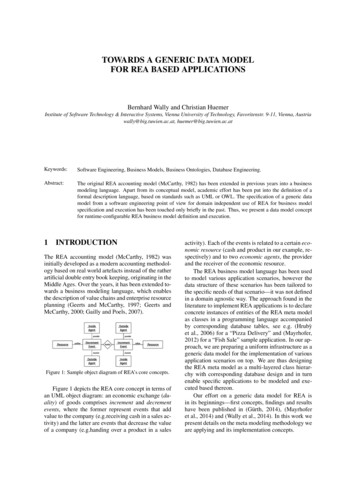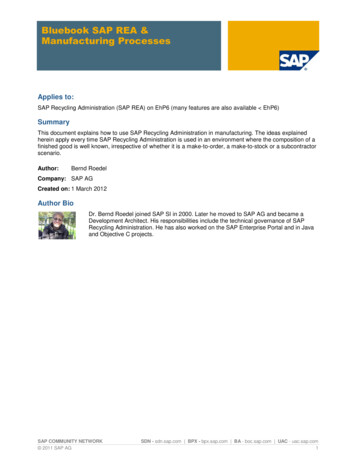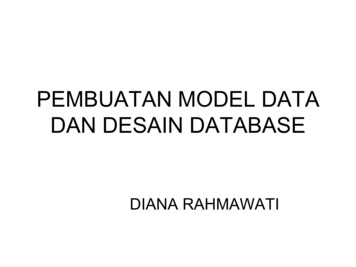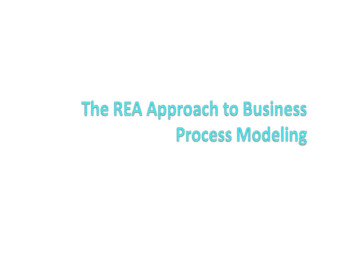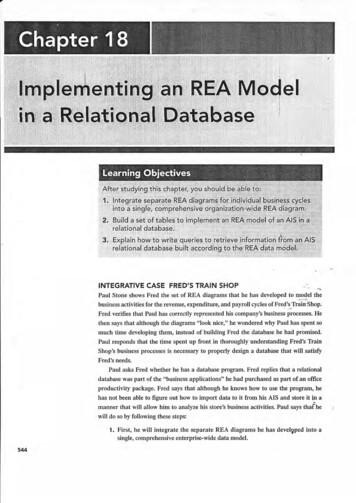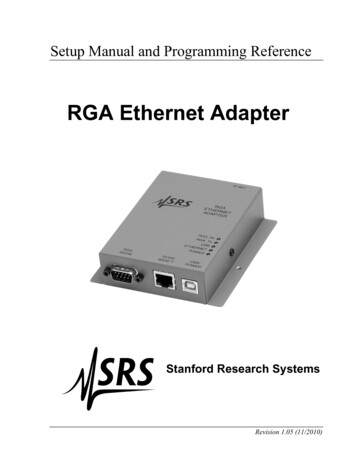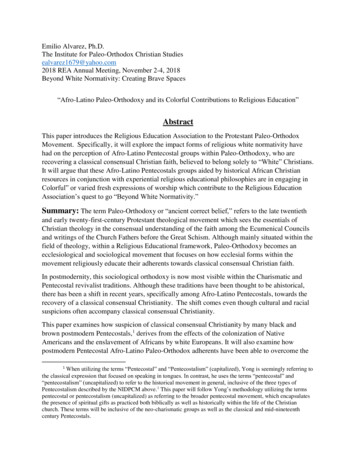
Transcription
Emilio Alvarez, Ph.D.The Institute for Paleo-Orthodox Christian Studiesealvarez1679@yahoo.com2018 REA Annual Meeting, November 2-4, 2018Beyond White Normativity: Creating Brave Spaces“Afro-Latino Paleo-Orthodoxy and its Colorful Contributions to Religious Education”AbstractThis paper introduces the Religious Education Association to the Protestant Paleo-OrthodoxMovement. Specifically, it will explore the impact forms of religious white normativity havehad on the perception of Afro-Latino Pentecostal groups within Paleo-Orthodoxy, who arerecovering a classical consensual Christian faith, believed to belong solely to “White” Christians.It will argue that these Afro-Latino Pentecostals groups aided by historical African Christianresources in conjunction with experiential religious educational philosophies are in engaging inColorful” or varied fresh expressions of worship which contribute to the Religious EducationAssociation’s quest to go “Beyond White Normativity.”Summary: The term Paleo-Orthodoxy or “ancient correct belief,” refers to the late twentiethand early twenty-first-century Protestant theological movement which sees the essentials ofChristian theology in the consensual understanding of the faith among the Ecumenical Councilsand writings of the Church Fathers before the Great Schism. Although mainly situated within thefield of theology, within a Religious Educational framework, Paleo-Orthodoxy becomes anecclesiological and sociological movement that focuses on how ecclesial forms within themovement religiously educate their adherents towards classical consensual Christian faith.In postmodernity, this sociological orthodoxy is now most visible within the Charismatic andPentecostal revivalist traditions. Although these traditions have been thought to be ahistorical,there has been a shift in recent years, specifically among Afro-Latino Pentecostals, towards therecovery of a classical consensual Christianity. The shift comes even though cultural and racialsuspicions often accompany classical consensual Christianity.This paper examines how suspicion of classical consensual Christianity by many black andbrown postmodern Pentecostals,1 derives from the effects of the colonization of NativeAmericans and the enslavement of Africans by white Europeans. It will also examine howpostmodern Pentecostal Afro-Latino Paleo-Orthodox adherents have been able to overcome theWhen utilizing the terms “Pentecostal” and “Pentecostalism” (capitalized), Yong is seemingly referring tothe classical expression that focused on speaking in tongues. In contrast, he uses the terms “pentecostal” and“pentecostalism” (uncapitalized) to refer to the historical movement in general, inclusive of the three types ofPentecostalism described by the NIDPCM above.1 This paper will follow Yong’s methodology utilizing the termspentecostal or pentecostalism (uncapitalized) as referring to the broader pentecostal movement, which encapsulatesthe presence of spiritual gifts as practiced both biblically as well as historically within the life of the Christianchurch. These terms will be inclusive of the neo-charismatic groups as well as the classical and mid-nineteenthcentury Pentecostals.1
stigmas associated with this form of white normativity through exposure to African Christianresources in conjunction with experiential religious educational philosophies.The research presented is qualitative and will adopt a historical-critical methodology inconjunction with literature-based reviews and insights from the practice of Afro-Latino PaleoOrthodox communities.INTRODUCTIONIn his widely celebrated book The Household of God: Lectures on The Nature of TheChurch (1953), Leslie Newbigin in responding to the question “by what is the Churchconstituted?”2 argues that the church’s nature is inherently Protestant, Catholic, and Pentecostal.Since its publication, The Household of God has been hailed by many within Protestantism asone of the pioneering works responsible for the various theological shifts leading to thedevelopment of the Paleo-Orthodox Movement. Paleo-Orthodoxy or “ancient correct belief,”3refers to the late twentieth and early twenty-first-century Protestant theological movement whichsees the essentials of Christian theology in the consensual understanding of the faith among theEcumenical Councils and writings of the Church Fathers before the Great Schism.Because it holds fast to classic consensual faith, Paleo-Orthodoxy should never beconfused with “neo-orthodoxy”4 the twentieth-century Protestant theological movement alsoknown as “Crisis” or “Dialectical theology.”5 Neither should it be identified totally with the term“Protestant-Orthodoxy,” a “phase of orthodoxy that characterized both Lutheran and Reformedtheology after the sixteenth-century Reformation,”6 and beyond. At its core, the Paleo-orthodoxMovement emphasizes a communitarian approach towards canonical theology, inclusive of St.Vincent of Lerin’s Commonitorium as its extra-canonical normative interpretive arbiter. To thisend, postmodern Protestants looking to recover classic consensual orthodoxy problematize themodern historical-critical method of biblical interpretation, providing as its corrective, a classicalconsensual approach to biblical exegesis.Although, Newbigin’s book stands as a modern theological primer for the PaleoOrthodox Movement, its leading figure, a significant contributor, and the one responsible forcoining the term Paleo-Orthodoxy has been Thomas C. Oden. Oden, formerly the Henry AnsonButtz Professor of Theology at Drew University, at the time of his death was responsible forwriting numerous works about Paleo-Orthodoxy including but not limited to, The Rebirth of2. Leslie Newbigin, The Household of God: Lectures on the Nature of the Church (Eugene,Oregon: Wipf & Stock Publishers, 1953), 9.3Kenneth Tanner and Christopher A. Hall, ed., Ancient and Postmodern Christianity: PaleoOrthodoxy in the 21st Century (Downers Grove, Illinois: InterVarsity Press, 2002).4. Thomas C. Oden, Rebirth of Orthodoxy: Signs of New Life in Christianity (New York, NewYork: HarperCollins Publishers, 2003), 24.5. Encyclopedia Britannica, s.v. “neo-orthodoxy.” Chicago: Encyclopedia Britannica, 2009.https://www.britannica.com/topic/neoorthodoxy (accessed October 20, 2017).3. Encyclopedia Britannica, s.v. “Protestant-Orthodoxy,” Chicago: Encyclopedia Britannica,2009. oxy (accessed October 20, 2017).
Orthodoxy (2003), Classic Christianity: A Systematic Theology (2009), How Africa Shaped theChristian Mind (2009), and The Ancient Christian Commentary on Scripture (2001).7Theologian Robert C. Webber is another influential voice within the Paleo-OrthodoxMovement. Webber, a former Professor of Theology at Wheaton College, contributes to thedevelopment of the overall movement not only through theological frameworks but also pastoralperspectives which call for an evangelical appreciation of the historic Christian calendar,liturgical rites of worship, and a sense and an understanding of sacramental theology. Webberonce remarked, “The road to the future runs through the past.”8 His words are emblematic of asurging Protestant Paleo-Orthodoxy grappling with the socio-religious and socio-political effectsof postmodernity. Through an Ancient Future approach, Webber expresses the Paleo-Orthodoxcommitment to looking towards the early Christian church as a guide for addressing issues offaith that arise in our contemporary times. By the time of his death, Webber authored numerousworks on the subject including: Evangelicals on the Canterbury Trail (1985), Worship Old andNew (1994), Ancient-Future Faith (1999), Ancient-Future Time (2004) and Ancient-FutureWorship (2008). Webber was also the general editor for The Complete Library of ChristianWorship (1996), an eight-volume series covering topics pertinent to worship.Aside from its main theological framework, Paleo-Orthodox thinkers and authors havealso helped to spark the further development of many pragmatic ecclesiological shifts withinProtestantism in the form of national and international ecclesial bodies dedicated to the practiceof an amalgamated three-streamed (Evangelical, Charismatic, Sacramental) Christian identity.Churches many times identifying as part of either The Convergence Worship Movement, ThreeStreamed Movement or Ancient-Future Faith Movement, such as The Charismatic EpiscopalChurch and The Communion of Evangelical Episcopal Churches, have been either directly orindirectly spiritually influenced by Paleo-Orthodoxy. These organizations (made up mainly ofevangelical or Pentecostal/charismatic churches) have recovered historical, ecclesiologicalorthodoxy, which includes a sense of sacramentality, creedal identity, consensual authoritativeteaching, and liturgical worship. For the most part, they tend to follow the church’s liturgicalcalendar (Western or Eastern), celebrate the Eucharist every Sunday, and utilize some historicalprayer book as a guide towards the administration of the sacraments and the ceremonies of thechurch.Afro-Latino Pentecostal OrthodoxyMost recently and surprisingly, revivalist traditions like Pentecostalism and theCharismatic Movement, have demonstrated the most considerable interest in Paleo-Orthodoxy,despite their historical lack of orthodoxy.9 In particular, among Afro-Latino Pentecostals andCharismatics in the US, there has been a strong inclination towards a classical consensualrecovery. North American Pentecostalism as a twentieth-century movement rooted in Wesleyan7Unlike the other resources where Oden was the singular author, Oden served as the generaleditor for The Ancient Christian Commentary on Scripture.8. Robert E. Webber, Ancient-Future Time: Forming Spirituality Through the Christian Year(Grand Rapids, Michigan: Baker Books, 2004), 11.9Oden, in Rebirth of Orthodoxy states
and Holiness spirituality has undergone significant theological shifts over the last two decades.These theological shifts have been the by-product of cultural/racial integration and engagementwith various twenty-first century social, theological, scientific, and educational developments.The consequence of such integration by Pentecostals contributes to what James K. Smithidentifies as a “Pentecostal Philosophy.”10 For Smith, the task of a Pentecostal philosophy “is towork at articulating the worldview that is implicit in Pentecostal spirituality.”11This type of philosophical “Pentecostalization”12 as referenced by J. Kameron Carter,sees the finished work of Christ on the cross as disrupting the “linguistics of cultural and politicalnationalism, including the nationalism at work in how identity is conceived and performed.”13Here, the recovery of classical consensual orthodoxy on the part of Afro-Latino Pentecostalsbecomes part of a broader and developing Pentecostal philosophy, in that it re-assess the effectscolonialism, and slavery has had on identity politics in the Pentecostal tradition in general andthe Afro-Latino Pentecostal church in particular. As a practical consequence, Afro-LatinoPentecostal Paleo-Orthodoxy can be closely identified with what Amos Yong calls a “catch-all,neo-charismatic” category within Pentecostalism that “comprises 18,810 independent,indigenous, post-denominational groups.”14 These neo-Pentecostals or neo-charismatics, asidentified by the New International Dictionary of Pentecostal and Charismatic Movements(NIDPCM) are distinct from the classical Pentecostal movement (connected to the Azusa Streetrevival in the early 1900’s) and from the charismatic renewal movement, which began withinProtestantism and Roman Catholicism in the mid-1960’s.15From an Afro-Latino classical Pentecostal perspective, Christian consensual orthodoxy issuspiciously colonialist, Catholic, and ultimately White. Here, the perception of a Eurocentricwhite normativity as “the defining of cultural practices, attitudes, assumptions, and ideologies inthe wider society and culture using the white culture as the standard, the norm,”16 is still verymuch interconnected to the history between the rise of the African American church and theAmerican system of slavery.In his book, Becoming an Anti-Racist Church (2011), Joseph Barndt addresses the sameconcerns. In it, he states that in America “White slave masters taught slaves a twisted anddistorted version of the bible as part of their strategy of dehumanization and pacification. Theymisinterpreted and distorted scriptural passages, such as the one from Paul’s letter to Titus thatsays slaves should obey their masters. They supported theological perspectives that encourage10James K. Smith, Thinking in Tongues: Pentecostal Contributions to Christian Philosophy(Grand Rapids, Michigan” Eerdmans Publishing, 2010), xvii11Ibid., xviii12J. Kameron Carter, Race: A Theological Account (New York, NY: Oxford University Press,2008), 309.13Ibid., 30914. Amos Yong, The Spirit Poured Out On All Flesh: Pentecostalism and the Possibility ofGlobal Theology (Grand Rapids, Michigan: Baker Publishing, 2005), 18.15. Stanley M. Burgess and Eduard M. Van Der Mass, eds., The New International Dictionary ofPentecostal and Charismatic Movements (Grand Rapids, Michigan: Zondervan Publishing, 2002), xx.16Kathy Winings, The Challenges in Addressing White Normativity (Unification TheologicalSeminary Blog: 2017), hallenges-in-addressing-whitenormativity/
submission and obedience as a virtue. And they portrayed the biblical church as a white churchwith a white God who favors white people as a superior race.”17The colonial church’s genocide of the Natives and enslavement of Africans in Americamasked under the guise of missional gospel preaching has had long-lasting effects on how nonwhite Christians perceive their place within the broader church and society. One of the moreprominent adverse effects is how Afro-Latino Christians perceive their social and ecclesialidentity in comparison to white Christians. From such social and theological insecurities,undoubtedly rooted in the systemic racism of white normativity, emerges an indiscriminate andsuperficial assumption of ecclesial elements related to classical consensual Christianity. Thus,the challenge of identity politics and belonging as experienced by Afro-Latino Pentecostalscontinue to make the recovery of classical consensual Christianity problematic. Presently, themost obvious elements within the classical consensual recovery on the part of Afro-LatinoPentecostals have less to do with ecclesial adherences or allegiances, and more to do withattaining social and racial equity. For the most part, these superficial attempts at recovery arepractical in scope, often including ecclesiastical dress, designations of clerical rank (titles), andliturgical rituals. All of these are efforts to gain and convey a sense of ecclesial and socialvalidation. To this end, Afro-Latino Pentecostals must ask themselves the question, will whitesupremacy as a structural or societal system which privileges whites be allowed to continue to bea driving force for how and why Afro-Latino clerics look to recover classical consensualorthodoxy?The African American Joint College of Pentecostal Bishops is an example of an AfroLatino superficial recovery of orthodoxy linked to the effects of white normativity. The JointCollege, established in 1993, began when four African American Pentecostal bishops discussedthe need for training Pentecostal clergy, specifically for the episcopal office.18 Ultimately, theJoint College “seeks to accomplish the implementation of [its] core values through acomprehensive program of training college sessions offered twice annually in March andSeptember. The college also offers an Adjutant school, a Helpmeet and Episcopal companionsforum, Episcopal Installation Services to Reformations; a Scholarship Program, and anInternational College event that reconnects the American Episcopacy with the global church.”19Archbishop J. Delano Ellis, II, Primate of the Joint College of African AmericanPentecostal Bishops, helped the college grow into what is considered by many in the AfricanAmerican pentecostal community to be “the premier development center for the Episcopacy inthe African American culture specifically and the global Lord’s church generally.”20 Currently,every year the Joint college attracts over 600 clergymen (men &women) to its conferences,which represents over twenty-four million Christian believers over varying denominationsaround the world.17Joseph Barndt, Becoming an Anti-Racist Church: Journeying toward Wholeness (Minneapolis,Minnesota: Fortress Press, 2011). 5418. The Joint College of African American Pentecostal Bishopshttps://www.collegeofbishops.org/about (accessed December 12, 2017)19. Ibid.20. Ibid.
As a form of Afro-Latino Pentecostal, Paleo-Orthodoxy, the Joint College is still verymuch in the early stages of development. Members of the College have adopted Anglicanvestments, utilize Anglo-roman clerical designations in order to distinguish clerical ranks, andboast of having both eastern as well as western lines of apostolic succession. To date, however,the understanding and recovery of the more foundational elements of conciliar, or consensualorthodoxy (historical theology, liturgical worship, and sacramentality), remains limited. Thatbeing said, there are shifts which are slowly taking place within its ranks. Recently, BishopDavid Maldonado a graduate of the Certificate in Convergence Studies Program at New YorkTheological Seminary, and one of the few Latino Bishops in the Joint College has been entrustedto teach sacramental theology at the College’s yearly session. Bishop Maldonado in speaking ofthe College’s process towards a more foundational recovery of classical consensual orthodoxystates that “While our journey as clergymen toward orthodoxy began with a desire both to betterorganize ourselves within the episcopacy and to recover our own social identity, this Spirit-ledjourney also is leading us, albeit slowly, into matters of creedal identity along with a recovery ofsacramental and patristic appreciation.”21Despite the few instances where the recovery of orthodoxy seems superficial, there is abonafide and genuine yearning towards the recovery of deeper elements of classical consensualorthodoxy on the part of Afro-Latino postmodern Pentecostals. In these instances, the hurdles ofidentity politics and suspicion have been overcome by in-depth exposure to Christian Africanoriented resources, contextual formational programs, and religious educational philosophies thatvalidate experience as pnuematologically educational.Contextual Ministerial Formational ProgramsMost recently there have been some contextual ministerial formational programs created,dedicated to providing Afro-Latino Pentecostals with the formation and training needed topractice Paleo-Orthodoxy effectively. These programs such as the Robert Webber Institute ofWorship and The Institute for Classical Christian Studies, usually are housed within a theologicalseminary or university and act as a corrective to the limited superficial recovery of classicalconsensual orthodoxy on the part of organizations like the Joint College of African AmericanPentecostal Bishops.Worthy of a more comprehensive analysis for its success within an Afro-Latino context isthe Certificate in Convergence Studies program at New York Theological Seminary. This oneyear program was designed with Afro-Latino lay and ordained leaders in mind and provides anintroduction to the theology and practice of Ancient-Future thought. Classes are provided inthree online semesters (six courses) and two 5-day intensive retreats. Subjects covered within thethree online semesters include; an introduction to Paleo-Orthodoxy, liturgical and sacramentaltheology, patristic theology, biblical exegesis, church renewal and missiology and the philosophyand theology of leadership. The two 5-day intensives are divided into a summer and wintercourse. The Summer intensive “Special Issues in Worship and Theology,” introduces students tothe three major streams (evangelical, sacramental, charismatic) within the Christian tradition21. Bishop David Maldonado, Bishop in the Joint College of African American PentecostalBishops, interview by phone by author, December 1, 2017.
exploring how they effectively amalgamate within Protestant worship, while the Winter intensiveintroduces students to the historical rites, rituals, and rubrics of the Christian church. It alsoexamines, compares and contrasts Roman Catholic, Eastern Orthodox and Anglican prayerbooks and processes of a functional liturgy. The objective is to develop contextual aides forcelebrants towards orderly movement during worship.Since 2015, the Certificate in Convergence Studies program at NYTS has matriculatedover 50 students and graduated over 20, all from Afro-Latino backgrounds. Of those 20 whohave graduated from the program 7 of them have gone on to complete graduate work at NYTSper the Memorandum of Understanding between the seminary and the certificate program. Froma ministerial pastoral perspective, the program has helped to better prepare approximately 18postulants (men and women) for Holy Orders within their respective churches. Most recently, thecertificate program has become a stand-alone institute (The Institute for Paleo-OrthodoxChristian Studies) but has remained in partnership with New York Theological Seminary andother theological seminaries and universities, thereby continuing to offer opportunities for highereducation to a student population for whom this was once an impossibility.Early African Christian ResourcesFor Afro-Latino Pentecostals looking to recovery classical consensual orthodoxy isneither prudent nor practical to look solely to Eurocentric models of Christian orthodoxy. ForOden, to exclude Early African Christian resources from Afro-Latino Paleo-Orthodox formationresembles a wise owl (representing philosophy) with blinders on that can only fly after the day isdone (reality).22 The analogy, is that of philosophical inquiry which never took care to fly overAfrica. Yet, the current reality is that exposure to early Christian African resources continue tobridge the great chasm between evangelical Protestantism and Paleo-Orthodoxy for Afro-LatinoPentecostals. Such African Christian scholarship has helped debunk far-fetched and falseEurocentric notions of Christian missional efforts embedded within colonialism and slavery.Here, the outrageous claim that slavery as an institution brought Christianity to the heathen fromacross the ocean (as believed by many Afro-Latino Christians) is problematized by establishingAfrican Christian teaching within the patristic era which predates modern colonialism. This earlyAfrican orthodoxy according to Oden, is “the form of classic Christian consensual teaching thatwas first planted in Africa by Africans from Mark to Clement to Tertullian to Cyprian toAugustine to Cyril the Great – All African born, all affirming the same core faith.”23 Odenthrough his writings on early African Christianity such as, Early Libyan Christianity (2011), TheAfrican Memory of Mark (2011) and The Rebirth of African Orthodoxy (2016) ventures to showthat the Western Christian mind benefits from how African thinkers shaped dogma, spiritualformation as well as providing a pattern for the early ecumenical councils.24 Here, while anexaggerated Christian Afro-centrism must be rejected as historically imbalanced, the sometimes22Thomas Oden, The Rebirth of African Orthodoxy: Return to Foundations (Nashville, TN:Abingdon Press, 2016), 25.23Ibid., 1.124Thomas C. Oden, How Africa Shaped the Christian Mind: Rediscovering the African Seedbedof Western Christianity (Downers Grove, IL: InterVarsity Press,2007), 43.
forgotten story of Christian thought as developed in Africa has helped Afro-Latino Pentecostalslook beyond white normativity in their recovery of classical consensual orthodoxy.While Oden’s writings concerning Early African Christian thought has been instrumentalin re-directing the Afro-Latino Pentecostal mind towards the recovery of classical consensualthinking, the rediscovery of Afro-Latino saints and martyrs have provided incarnationalexamples of holy living. Here, ascetic monks such as Moses the Black along with Spanish Saintssuch as St. Martin de Porres have aided Afro-Latino Pentecostals in placing a culture to orthodoxpractice and belief.Religious Educational PhilosophiesThe last and most intriguing factor within Afro-Latino Paleo-Orthodoxy seems to be thereligious educational philosophies which undergird experiential liturgical and sacramentalworship as the more foundational elements of classical consensual recovery. Here, JohnDewey’s criteria for experiential education which describes the dual movements involving theprinciples of interaction and continuity that together provide “the measure of the educativesignificance and value of an experience,”25 has proved to be invaluable. An experience, or thequality and value thereof according to Dewey, can be deduced from its ability to be educative ormis-educative, but only through the lens of continuity which “promotes desirable futureexperiences.”26 This interplay of experiential educational objectives and internal conditions thusforms what for Dewey can be described as a situation.27 For Dewey, “The two principles ofcontinuity and interaction are not separate from each other. They intercept and unite. They are,so to speak, the longitude and lateral aspects of experience.”28Similar to Dewey, for Gabriel Moran, “the keyword for beginning a description ofeducation is interaction.”29 Interaction is both subjective and objective in that it deals with howan organism and the various forms of life, in interaction, transform each other.30 Central toeducation as interaction is the concept of a sense of “end,” which according to Moran should beenvisioned as purpose or meaning but not termination. One the one hand, educationalinteractions are not random. They are processes that have purpose and meaning. They aim tolead those involved out toward some end, some greater sense of understanding or insight. At thesame time, educational interactions should not terminate or come to an end. Rather, if they are toprepare people to engage in the continual unfolding of their lives and human history, they mustbe ongoing and lifelong. Overall, educational interactions have an end (meaning, purpose,design) but are without end (termination).3125. John Dewey, Education and Experience (New York, New York: Touchstone Book, 1983), 45.26. Ibid., 27.27. Ibid., 42.28. Ibid., 44.29. 29. Gabriel Moran, Showing How: The Act of Teaching (Valley Forge, Pennsylvania: TrinityPress International, 1997), 156.30. Ibid., 150.31. Ibid.
Both Dewey and Morans’ principles of experiential education as interaction andcontinuity with forms of life “with end and without end,” play a dual role in the life of AfroLatino Paleo-Orthodox adherents. First, the principles aid in recovering experiential religiouseducation’s proper place against the backdrop of white normativity. Secondly, the principlesvalidate for Afro-Latino Pentecostals the notion of a religious orthopathy as religiously educativeand thus vital to the recovery of orthodoxy. A brief treatment of both theories is not onlyessential to this study, but also deserving.The concept of education as interaction of forms of life with end but without end(interaction & continuity) when placed in correlation with colonialism and slavery’s owncatechetical processes reveals a conflictive dilemma. Here, those enslaved were provided withenculturating Christian teachings which espoused Christian values in an attempt to bring theminto church membership but without providing them with their freedom.32 To this end educationwithout freedom becomes stagnate in its ability to be either truly religious or educational. Thus,if the educational system which colonialism and slavery operated aimed at providing Christianteaching disconnected from the concept of Christian freedom, ultimately rupturing the end butwithout end tension of educative interaction, then according to Moran, “education is reduced tobeing someone’s possession, usually what the rich, the powerful, or some elite have controlof.”33 Furthermore, for Moran, “When the double meaning of end collapses, that is wheneducation is either a possession or an instrument of control, the education becomes irreligious. Inthe precise meaning of the term, education becomes an idol. Education them competes withreligion which has as central to its meaning the de-idolizing of false gods.”34 To this end, AfroLatino Pentecostals especially within the classical sense, continue to be influenced by a whitenormative perspective which has caused them for the most part, to shun academic education inlieu of the Holy Spirits experiential leading.Methodist theologian Theodore Runyon in studying John Wesley’s focus onexperientialism coined the term orthopathy to describe how right affections fuse with rightbeliefs (orthodoxy) and right practices (orthopraxy) within Wesley’s theological framework. 35For Runyon, orthopathy is a religious experience, an event of knowing between the DivineSource (God) and a human participant (believer), providing a necessary but currently missingcomplement to orthodoxy and orthopraxy.36 Steven Land, a prominent Pentecostal theologianand author of the book Pentecostal Spirituality (1993), in sharing Runyon’s thought states that“The personal integrating center of orthodoxy and orthopraxy is orthopathy, those distinctiveaffections which are belief shaped, praxis oriented, and characteristic of a person. Affections are32Jospeh Barndt, Becoming an Anti-Racist Church, 41.Gabriel Moran, “Of A Kind and To A Degree: A Roman Catholic Perspective,” in Does theChurch Really Want R
The Institute for Paleo-Orthodox Christian Studies ealvarez1679@yahoo.com 2018 REA Annual Meeting, November 2-4, 2018 . Theologian Robert C. Webber is another influential voice within the Paleo-Orthodox Movement. Webber, a former Professor of Theology at Wheaton College, contributes to the . Worship (2008). Webber was also the general .
